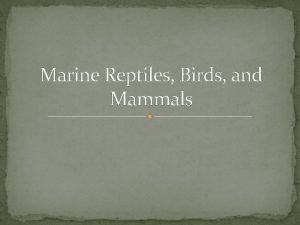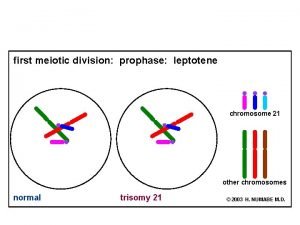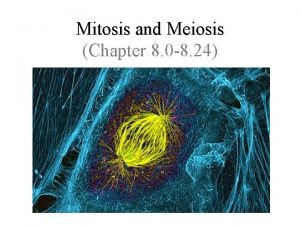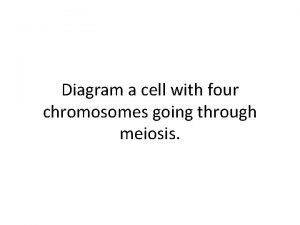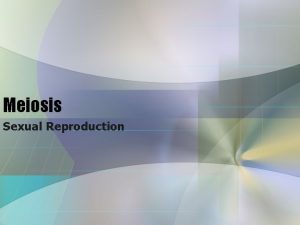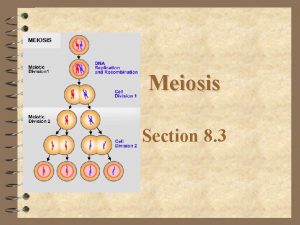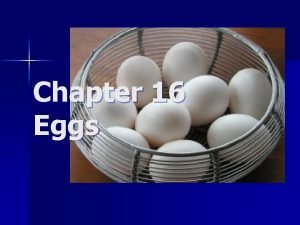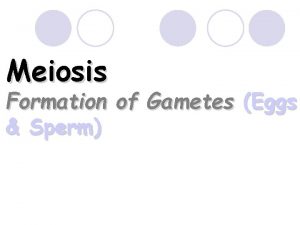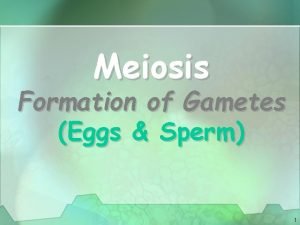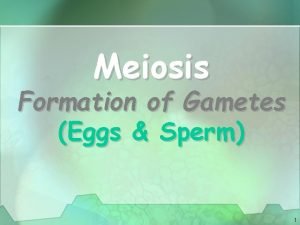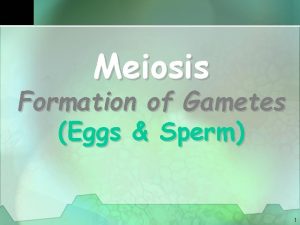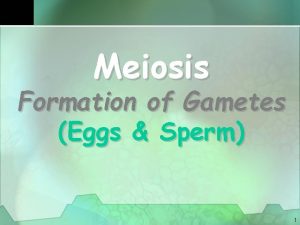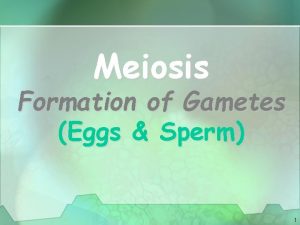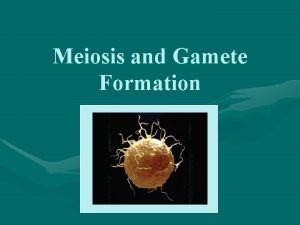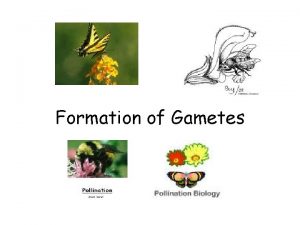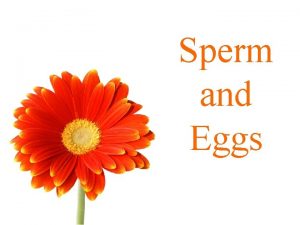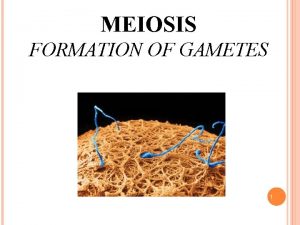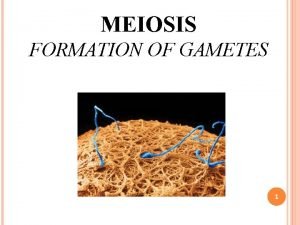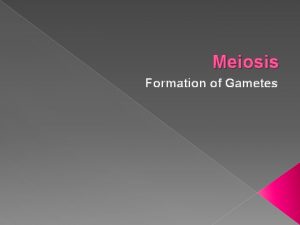Meiosis Formation of Gametes Eggs Sperm 1 Important













- Slides: 13

Meiosis Formation of Gametes (Eggs & Sperm) 1

Important Terminology ü Diploid (2 N): “two sets”; a cell that has 1 set of chromosomes from its female parent and 1 set from its male parent (=2 copies of each chromosome) ü Homologous: each chromosome from one parent has a corresponding chromosome from the other parent. ü Haploid (N or 1 N): ü the number of chromosomes in a gamete (sex cell – egg or sperm) ü Only one copy of each chromosome 2

Polypoidy ü What would this mean? ? ? ü More than diploid (more than 2 sets of chromosomes) ü Triploid (3 N) ü Tetraploid (4 N) ü Not viable (“survivable”) in humans ü Seedless watermelons are triploid, formed from a cross between diploid and tetraploid watermelons. ü Because the 3 copies of the chromosomes won’t line up correctly during meiosis, meiosis is halted, so no gametes (seeds) are formed. 3

Definition of Meiosis üThe process of reduction division in which the number of chromosomes per cell is cut in half (reduction) through the separation (division) of homologous chromosomes in a diploid cell üHomologous chromosomes (“homologs”): “matched” chromosomes (not necessarily identical); both before and after replication! 4

Facts About Meiosis üPreceded by interphase which includes chromosome replication üTwo meiotic divisions --- Meiosis I and Meiosis II üCalled reduction division üOriginal cell is diploid (2 n) üFour daughter cells produced are monoploid (1 n) (AKA, haploid) 5

Facts About Meiosis üDaughter cells contain half the number of chromosomes as the original cell. üProduces gametes (eggs & sperm) üOccurs in the ütestes in males (Spermatogenesis) üovaries in females (Oogenesis) 6

More Meiosis Facts ü Human cells start with 46 double stranded chromosomes (2 n). üAfter 1 st division - 23 double stranded chromosomes (n) in each of 2 cells üAfter 2 nd division - 23 single stranded chromosomes (n) in each of 4 cells ü Occurs in our germ cells that produce gametes 7

Why Do We Need Meiosis? üIt is the fundamental basis of sexual reproduction. üTwo haploid (1 n) gametes are brought together through fertilization to form a diploid (2 n) zygote. 8

Fertilization – “Putting it all together” 2 n = 6 1 n =3 9

Replication of Chromosomes ü Replication is the process of duplicating a Occurs in chromosome Interphase ü Occurs prior to division (interphase) ü Replicated copies are called sister chromatids. ü Held together at centromere 10

A Replicated Chromosome Gene X Homologs (same genes, different alleles) Sister Chromatids (same genes, same alleles) Homologs separate in meiosis I and therefore different alleles separate. 11

Meiosis Forms Haploid Gametes ü Meiosis must reduce the chromosome number by half. ü Fertilization then restores the 2 n number. from mom from dad child too much! meiosis reduces genetic content The right number! 12

Meiosis: Two Part Cell Division Sister chromatids separate Homologs separate Meiosis II Diploid Haploid 13
 Killer whale eating sea lion
Killer whale eating sea lion Leptotene
Leptotene Function of meiosis
Function of meiosis Meiosis makes gametes
Meiosis makes gametes Meiosis
Meiosis Meiosis reproduction
Meiosis reproduction Selecting and storing eggs
Selecting and storing eggs Anaphase
Anaphase Chapter 10 meiosis 1 and meiosis 2
Chapter 10 meiosis 1 and meiosis 2 Meisis 1 and 2
Meisis 1 and 2 Chapter 10 section 10.2 meiosis worksheet answer key
Chapter 10 section 10.2 meiosis worksheet answer key Crossing over occurs during:
Crossing over occurs during: Meosis prophase 2
Meosis prophase 2 Differences between mitosis and meiosis
Differences between mitosis and meiosis
